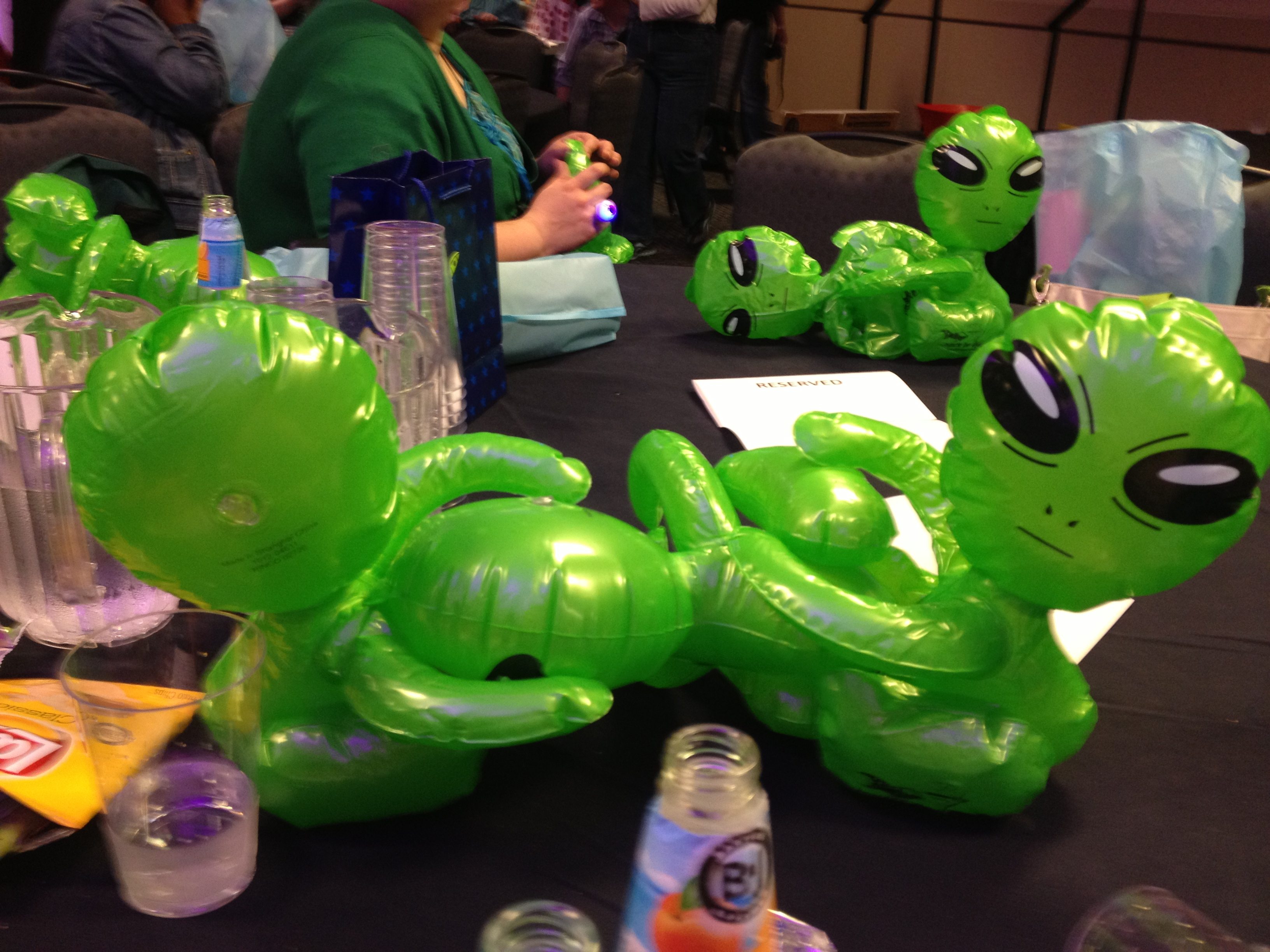
This week’s adventures climbing the cliffs of insanity are centered on my trip to the Romantic Times Booklovers Convention in Kansas City where I dived into workshops on the invention of romance and how to write comics, topics that are not so dissimilar. Both deal with how to translate myth into storytelling.
So far, the most surprising thing (not the aliens, as give romance writers a little alcohol and props and they’ll have some fun) has been the blizzard that rose up yesterday. Even a New Englander like myself is a little disconcerted at snow in May. The Australian contingent at the conference had to go outside to experience the snow as apparently it’s rare where they come from. (Though the Southern Californians were appalled.)
I should definitely ask resident GeekMom weather expert Patricia Vollmer about the origins of the storm.
A geeky sight awaited me on arrival as my room at the Westin overlooks the Legoland Discovery Center. But then I dived into something that will always fascinate me: writing and why romance is the genre that gives women hope for the future.
I attended an “Invention of Romance” panel with authors Renee Bernard as moderator and featuring authors Eileen Dreyer, Elizabeth Hoyt, Laura Kinsale, Erin Knightley, and Delilah Marvelle. The panel idea was inspired by Harold Bloom’s Shakespeare: Invention of the Human and the roots of romance writing, going back to Le Morte d’Arthur and focused on how romance contributes to the mythos of human existence.
“We update the fairy tale,” Dreyer said. “Genre fiction is the retelling of our old mythologies. It’s not just women telling women there’s hope for the future it’s also women telling women what they should want from a relationship. We are the heroines of our own story.”
“We write it’s possible to love each other and not take crap either,” Knightley said.
Kinsale, a romance legend, talked about Anne Carson’s poetry about Eros and how stories are the lover, the loved and the space in between, which causes the conflict. In Greek tradition, these stories end badly, in the romance genre, they end well.
Dreyer, who worked as a nurse in a trauma ward, says she writes to understand the horrible things people do to each other and yet show how there’s still hope for them. Marvelle said she needs to write what she has survived. To which Dreyer, who said she had a perfect childhood, responded with “You are my hero because you have survived and triumphed.” Marvelle said there’s a little bit of her firefighter husband in each of her fictional heroes.
Hoyt said she’s not the hero of her own books at all but agreed she’s writing modern fairy tales. “I want to write things better than real life, I want EPIC, something strongly colored. I want to read uber-love.”
As I’ve said before, romance is the best selling fiction genre in the world, with the majority of paperback book sales. The true appeal is exactly what the panelists said, that these are stories by women talking about women’s experiences. The outliers among romance tend to be picked up by non-romance readers and spun into something, such as Fifty Shades of Grey* but even there, the appeal seems to be figuring out what the heck this mysterious and strange guy will do next, though I’m sure some are reading to find out the bondage scenes which bear little resemblance to real-life BDSM culture.
Face it Tiger, You Just Hit the Jackpot!
The next day, I did hit the jackpot, spending two hours in a workshop about how to write comics, presented by authors Anne Elizabeth, Bernard again, Angela Knight, C.H. Amirand, and Susan and Clay Griffith.
The group has some serious geek credentials and the Clays have a great story over meeting in a bookstore after Susan bought Uncanny X-Men #201 where Storm and Cyclops fought for leadership of the X-Men.
Elizabeth had some terrific tips from being edited by Alisa Kwitney, who edited Neil Gaiman’s Sandman series for DC Comics Vertigo Imprint.
Essentially, first decide what each comic page will be about. Then get a bunch of sticky notes to represent the panels and use those sticky notes to play with the panel by panel construction. As someone who plots out their comics with legal pads and stick figure drawings, this was a revelation.
Knight, who first published comics with Brian Stelfreeze as her artist, said comics forces a writer to take their audience always into account, especially in regards to the art style. She said you absolutely have to emphasize just the right image in the story to convey complex meanings.
“Save the splash page for that moment,” she said, adding that she used only a maximum five panels per page so the art would have the greatest impact.
As I’ve discovered when writing comics, Bernard, who just had her first comic story published, said working with the visual medium forces the writing to become more spare and more visual, streamlining the storytelling.
So how did I celebrate learning all this? I did what any geek would do. I became Wonder Woman.




